|
He launched and edited over 30 videogame magazines, helped launch two videogame TV shows, founded his own successful publishing company and became the best known journalist celebrity of his time. We caught up with the Dave Perry to reminisce about all these achievements and how it all lead to one of his very first passions...
|
|
Out-of-Print Archive: Can you cast us back to your earliest gaming memories? Where did it all start? Did you read videogaming magazines yourself?
Dave Perry: Well, I remember owning an old Pong console way back in the day... think we bought it at Woolworths. But despite all the usual dalliances with Spectrums and Atari cartridge systems etc. my really serious interest in videogaming, rather than home computing, started with the Amiga 500. I still have that machine to this day, with its 500k upgrade. Nothing beats a game of Kick Off, with Competition Pro sticks. Especially if you can find an opponent to play against.
As for magazines... I wasn’t overly loyal until Ace and Zero came out. I absolutely loved those magazines. Before then I would just buy whatever I could get my hands on. I wanted to know everything.
|
Out-of-Print Archive: You managed to get into videogame journalism. How did this come about?
DP: I was always writing for magazines and fanzines and sending reviews in to the editors. Some got published, some didn’t. These were great days for writers as well as developers. There was no blueprint. The whole games revolution was just that... a revolution. We were working it out as we went along. There were no rules. Then one day, as I was happily reading an Amiga magazine I saw an advert for a mail order company called Special Reserve, which not only gave you the chance to buy your games at discounted prices, it also sent you a subscriber magazine on a regular basis. I joined up and got the magazine, along with a copy of Drakkhen, however I was not overly impressed with the publication and thought to myself... “I could do this.”
So I applied for a Deputy Editor’s position and got the gig. I moved to London within the week and slept in my Mini until I found affordable accommodation. Not a problem for me, I had been travelling with carnivals and fairgrounds before that and sleeping in a converted bus. Aside from my freelance reviewing, that was my first full-time magazine position. Within a year I was Publishing Manager for the company, almost single-handedly producing three different magazines at a time. It was a great introduction, both to the world of publishing and the games industry at large.
|
OoPA: You were approached by Hewland International to help launch a videogaming TV show called GamesMaster. What are your recollections on getting this historic TV show to the screens?
DP: Oh yeah, well this was when everything really started to go crazy for me. I had heard that a TV company was considering putting a show together about videogaming and when they invited me down to the Docklands to meet them I didn't really know what |
|
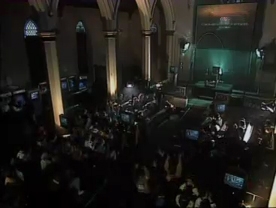
|
| to expect. You have to remember that this was around 1990-1991. The Mega Drive had not long been released, there was no internet and the games industry still centred largely around computer whiz kids programming from their homes. Hardly anyone had satellite TV, and there were only four TV channels to choose from. Being on TV was a huge deal. I could |
|
GamesMaster television’s first ever videogames magazine show. Episode 1 opened in the misty hue of a church interior. Video arcade games lined the far end of the wall and the crowd sat along the pews. |
| hardly believe that I was being offered a chance to enter such a magical world. |
Once I was on board I really did have a wonderful, wonderful time, although I do remember long, cold, dark tube rides to the Isle of Dogs very early in the morning every day. And long, late night rides home. What we were doing was so unprecedented that we were literally making it up as we went along. Trying to come up with a format for the show, a way to accurately reproduce challenges on software that isn’t made for such things, even what award to give winners. You can’t give anything with too much value to it, there are laws against that in broadcasting... or there were. So eventually a peripherals manufacturer called Spectravision and I came up with the idea for the Golden Joystick. I was given one by the production team when I eventually left at the end of Season One, as recognition of my work on the creation of the show. I still have it to this day.
Other memories? Getting very drunk at a Christmas party and barricading Hewland’s directors in a toilet (did not go down well). The excitement of scouting for locations and eventually deciding to put the whole show inside a church. And the feeling I got on that first day of filming, when the smoke machines and lasers kicked on for the first time and the audience cheered. The feeling that “Oh my God we’ve done it. This is really happening.”
|
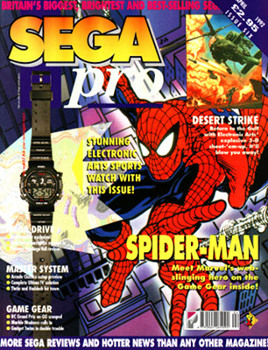 |
|
OoPA: By 1992 you had moved over to Paragon Publishing, a magazine publishing outfit just founded by two former Future employees. What were your reasons for joining such a small company?
DP: Jane Hewland had asked me to stay in television. I remember her exact words... “You’re a television person.” But something in me longed for the cut and thrust of publishing. There really is nothing like it. The deadlines, the pressure, the opportunity to influence the opinions of thousands of others. It’s like intellectual opium for the ego. A nationwide soap box. To be honest I was always a bit too working class for television. I just felt like a jammy sod to even have had the opportunity in the first place, which is ironic as I continued to work on TV shows in some form or another for the next eight years or so. |
| But I always felt that I belonged on magazines. I knew which buttons to push and how to make them tick. When the chance came to join Paragon it was perfect for me. I like working for the underdogs, the small, hungry organisations where I can make a big impact. I’m not good at being a small cog in a big machine. I’m far too aggressive and ambitious for that. Paragon was going places and I could feel it, plus I got on brilliantly with the owners there. We started off in an office above an electronics shop and we ended up in Bournemouth with over 150 employees. Seems I was right... again.
|
OoPA: Your first position at Paragon was as Designer on Sega Pro. We always thought that you were on the magazine as a games reviewer before working your way up. Where did the Designer position come from and what input did you have for the magazine in its early issues?
DP: This is a popular misconception. You see, Magazine Designers got paid almost double what reviewers got back then. I had a BA Hons Degree in Art and Design from the Bath Academy of Art and a Diploma in Graphic Design from South Devon Technical College. Also, my time as Publishing Manager before getting into the TV thing meant I could pretty much do any job you wanted me to on a magazine. So I went for the job with the most responsibility and with the best salary. Eventually of course I got moved across into the Editorial chair where I could take control of the whole damn thing, but initially I was the magazine’s designer. Which satisfied the artist in me for a while.
|
OoPA: While appearing on GamesMaster and Games World you soon became known as ‘The Games Animal’ as well as wearing a bandana. Where did the name and the bandana idea come from?
DP: The Games Animal name came about whilst I was playing NHL 93 on the Mega Drive one day. You see, no-one could beat me on that game and one day whilst I was playing, the Public Enemy song “Bring the Noise” was playing in the background. Chuck D was |
|
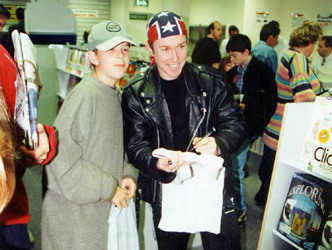
|
| singing something like “Once again it’s me the Rhyme Animal, the Unstoppable me.” So I just started boastfully singing along with “Once |
|
Dave signs an autograph for a fan wearing his trademark bandana |
again it’s me the Games Animal, the Unstoppable me.”
And so I became The Unstoppable Games Animal, which later got shortened. Before that I had been known as Dave‘The Kid’ Perry, when I was the Editor of Mega Power and used to challenge every company’s games experts to come a play me on their own games in the magazine. But thankfully people seem to have forgotten about that one. I never lost a challenge by the way.
As for the Bandana, I was working on the second season of GamesMaster and had decided that I want to grow my short hair cut out, but it looked shite. So I started to wear a bandana to filming and Director Cameron McAllister thought it looked good and said I should keep it, so I did, and it became a really strong image for me. Very iconic even to this day. If you say to anyone who played games during that era, “The guy in the bandana...” they will know who you mean. Which is really something, right? Later on I started to want to appear more without it, but Jane Hewland was always very insistent that I should keep it. She said no one should so easily discard such a strong trademark. Now, with hindsight, I can see that she was right. |
OoPA: What did you feel about the GamesMaster magazine that was launched by Future Publishing?
DP: I hated it because they were our competition by then. But secretly I loved the magazine. After all I still viewed GamesMaster TV show as my baby. I did feel however that I could have been involved with the publication a bit more. It seemed to keep a deliberate distance from the TV show, apart from using the graphic stylings, which was probably a good idea from a business point of view I guess. |
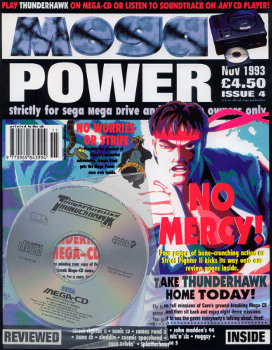 |
|
OoPA: Following the success of Sega Pro, Paragon were able to launch a second publication called Mega Power in 1993, which had the honour of being the first videogaming magazine to covermount a CD. These must have been exciting times for a magazine editor?
DP: Oh yes. Mega Power had quite a stormy early life, with me taking over as Editor after a few issues. At that point no console magazine had ever covermounted a demo CD, so when we decided to do it with Core Design’s Thunderhawk it was a very, very big deal indeed. Yet another massive first that would have far reaching consequences. I guess you could say we were something of a rudimentary prototype for the mighty Official PlayStation Magazine many years later. At this time I seemed to be involved in kicking down so many doors that my head was spinning. People have commented that I was often difficult to deal with, or |
| something of an egomaniac, but if you look at everything I was involved in, it’s not surprising that my manner might have been hard to take. I hardly had time to stand still. Like I mentioned earlier, we were constantly breaking new ground and that often involved making it all up as we went along. |
OoPA: 1993 also saw the appearance of Games World on Sky television of which you helped launch as presenter and co-commentator. Can you explain why Hewland came about launching a videogames TV show when they already produced a similar TV show in GamesMaster?
DP: I’m not sure what the business incentives might have been behind Games World, as I was no longer employed by Hewland at the time, but I think they were excited once again about doing something completely new. A show that broadcast five nights a week, with a growing satellite network was probably far too fantastic a challenge to turn down. Creatively they were able to try a lot more than they had with GamesMaster, while technology wise a lot of the groundwork had already been done on the previous show.
Jane Hewland did get in contact with me, and asked me to present one of the shows every week. However, she wanted me to be part of a three man presenting team, and I wasn’t really into that. I’m not keen on sharing the limelight. But I did agree to appear on the show and represent my magazines as a games champion to play against champions from all the other publishing houses. The UK’s (maybe the World’s) first ever televised Professional Games Players Tournament. I eventually won in the final against the Editor of GamesMaster magazine. Oh the irony. Another notch on the joypad. [Laughs.]
When they asked me to go back as a presenter for Season Two of the show, I of course said yes. This time I got my own show and contract. I guess I had earned it. The season ran for 26 weeks I believe, and it was during this time that I really learned my craft as a presenter.
|
OoPA: Just a year later, Paragon Publishing did manage to secure a videogaming TV show licence in Games World: The Magazine. With yourself as launch editor how did it feel to oversee a magazine based on a TV show that you also presented?
DP: Absolutely brilliant. I was very influential in getting this licence for Paragon. I designed the dummy covers, set up and attended the London-based meetings with Hewland etc. The company also gave me a free hand in headhunting and choosing my own team for the project. We even got given our own office to work out of.
We knew we couldn’t beat GamesMaster magazine in the circulation race, but we absolutely set out to beat the second placed magazine... the mighty Mean Machines, and we pulled every stroke possible in making that happen. Oh the stories I could tell.
Maybe I should write a book? |
|
 |
| Anyhow, this was yet another first I believe. Editing a magazine licensed around a TV show that also employs you as a presenter, and it was certainly the launch that put me on the map as an international gaming celebrity. I have to say also, that this was the best team I ever worked with on a games magazine. Absolutely top drawer every single one of them. We pushed ourselves and each other to the limits, and the early hours of the mornings. Cover books, big game exclusives, film crews in the offices and the now infamous tale of ‘Cocky Kid’ (that’s also a whole other story). Happy days. Truly the golden age of gaming for me. |
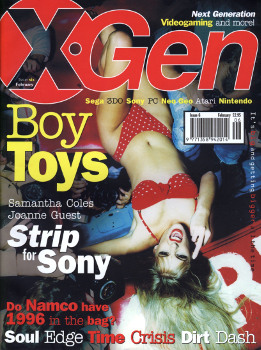 |
|
OoPA: During the summer of 1995, you launched another multi-format magazine called X•Gen. What can you tell us about this ambitious magazine?
DP: X•Gen was a hugely ambitious title as we wanted to attempt what has always been the Holy Grail of gaming magazines, and that is launch a multi-format publication that combines gaming with the other various lifestyle interests of its readership. It was meant to be a more lad’s mag version of Edge, if you like. Lovely Matt Laminated covers, beautiful and groundbreaking page designs and layouts, something of a self-indulgent low readership flagship title. I loved working on that magazine, but I think ultimately it confused the magazine buying public. Maybe it was ahead of its time? Maybe, we just didn’t get the balance right, or the cover price. |
|
I remember sitting down and eating lunch with Steve Merritt (formerly of Emap) once, after I had left Paragon, and he asked me what had been my favourite magazine, and I had said X•Gen. To which he told me he thought it was one of my weaker titles. Which surprised me. I guess beauty really is in the eye of the beholder sometimes.
|
OoPA: At the end of 1995 you were then tasked with launching a PlayStation magazine called Play. What can you tell us about the launch of the magazine, which is still being published to this day?
DP: Did I? It’s funny how time clouds things. I thought I launched X•Gen and Play at the same time... PowerStation later as a simultaneous launch with Ultimate Player, a multi-format solutions magazine. I would imagine you are right, everything is a bit of a blur around this time as I was becoming a bit of a publishing machine, launching simultaneous titles left, right and centre. I was also still the Managing Editor of Games World: The Magazine, the Official 3DO Magazine, Saturn Plus, Sega Pro etc. Plus travelling to London to present regularly on GamesMaster and Games World TV shows and taking part in exhibitions and shop openings all over the country. How did I do it? No, really. How? |
|
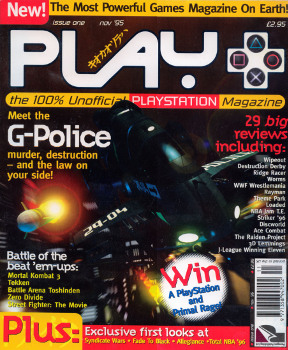 |
Back to your original question, launching two magazines simultaneously is a lot of work for anybody. But at the time the PlayStation Market was such a huge deal for every publisher, that there was a real race to get there first. Paragon had always had a good reputation for solutions magazines, since the early days of Console XS, so we knew we could nail that market with PowerStation. We even came up with a revolutionary way of laying out the magazine alphabetically rather than just using page numbers, keeping older codes and solutions as a constant while also adding newer guides.
Play on the other hand was later onto the market than we would have liked. We had hoped to be the first PlayStation magazine on sale, but another publisher beat us to the punch. However, we knew once again that the magazine we had created really had something. Its logo was sharp and stylish and we utilised a more square format to give the title an instantly recognisable feel on-shelf. Inside we had a small (very small) but immensely capable team, all dedicated to giving the new population of PlayStation fans the read they deserved. I am not surprised that the magazine is still around today. It always had something very special. It makes me proud to know it is still going strong.
|
OoPA: Of course, Ultimate Player, 3DO Magazine and Saturn Plus... What can you tell us about the launch of these little known publications?
DP: Saturn Plus was a late attempt by Paragon to get a hold on the new next generation Sega market. It was launched by my former Games World Games Editor Nicko 1-2, who I later also took to Rapide, but struggled to grab a foothold in the market, despite being launched with a playable cover disc. A lot of this was, I think, down to the steady demise of Sega as a viable format. Provider at the time. Ultimate Player was a multi-format solutions title, and 3DO magazine did exactly what it said on the tin. We launched it during the interim next gen period when 3DO, CD32, Jaguar, and CDi were all trying to grab a hold of the CD based games market. They of course all got their arses kicked by PlayStation and Saturn ultimately, but the 3DO retained a loyal following and we were proud when this became the official magazine for the format. Edited by Stuart Wynne, it was a title that I simply oversaw as Managing editor at Paragon. It was very good, and very techy. |
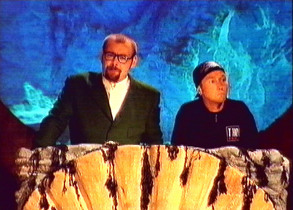 |
|
OoPA: As GamesMaster entered its sixth series, the friction between yourself and host Dominik Diamond increased, peaking with the Mario 64 challenge incident. Was there any reason for the seemingly increased tension between the two of you? This also wasn't the only time when matches were fixed, was it?
DP: I don’t know what started the friction between us. It definitely came more from his
|
| As series six of GamesMaster aired, tensions between Dave and Dom became evident |
|
side than mine. I was pretty isolated. It perhaps wasn’t helped when he left before Season 3 got under way, only to see me step in to co-host the show with Dexter Fletcher and help him get through a very |
| difficult time. Certainly from that moment on lines seemed to be drawn. I simply wanted to help make a great videogames show, that was my number one priority, a videogames show. What his problem was with me, I guess only he will know, because he certainly never spoke to me about it. Just made faces behind my back. Schoolboy stuff.
Of course it has been well documented that many challenges on GamesMaster were fixed through the years, with my Mario 64 moment being the most famous of these. But it all began as far back as the first series, when a young player (whose name I won’t mention) fluffed the Sonic rings collection challenge. It was not the result the producers wanted, so he was given another go. This kind of thing happened quite a bit, because the emphasis was often on putting the best show out possible, and that often meant ensuring that competitors reached the more interesting levels or areas in games, even if it meant letting them try again. Another classic example of this illusion of a ‘fair’ challenge was the supposed Tetsujin challenge on the latest Virtua Fighter coin-op that I presented in Season 6. The Tetsujin was supposed to be a Japanese champion, who had been flown over here to take on 100 UK Virtua Fighter fans. What he actually ended up playing against was 30 or so young kids that were just visiting from a local school. They didn’t have a clue what they were doing or even how to control the game in some cases. Lambs to the slaughter. I hated that kind of thing and told the production team so. It was sarcastically suggested that I played him instead, which to their surprise I said I would. It didn’t happen.
What I struggled to understand was that GamesMaster was a TV show, first and foremost. It was an aspect of the production that I never completely came to terms with. It certainly wasn’t how I had conceived it. I wanted it to be just about the games. |
| In part two of the interview, Dave talks about leaving Paragon Publishing, working for a videogame software company, taking on the might of the Official PlayStation Magazine, launching his own magazine publishing company, setting up his own business in his home town and more... |
|
|
|